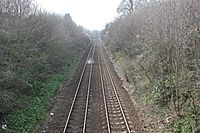Godminster Lane Quarry and Railway Cutting facts for kids
| Site of Special Scientific Interest | |
 |
|
| Area of Search | Somerset |
|---|---|
| Coordinates | 51°06′34″N 2°27′18″W / 51.1094°N 2.4549°W |
| Interest | Geological |
| Area | 0.8 hectares (0.0080 km2; 0.0031 sq mi) |
| Notification | 1971 |
Godminster Lane Quarry and Railway Cutting is a very special place in Somerset, England. It's a small area, about the size of a football field (0.8 hectares), that has been protected since 1971. This site is known as a Site of Special Scientific Interest (SSSI) because it holds important clues about Earth's ancient past.
What Makes This Place Special?
This site is super important for scientists who study rocks and Earth's history. It helps them understand the "Inferior Oolite" limestones. These are types of rocks that formed a very long time ago, during the Middle Jurassic period. That was about 175 million years ago! Back then, this area was covered by a warm, shallow sea.
A Peek into the Past
Imagine a time when dinosaurs roamed the land. At the same time, this part of Somerset was underwater. Over millions of years, tiny bits of shells, sand, and other materials settled on the seabed. These layers slowly turned into the limestone rocks we see today at Godminster Lane.
Rocks and Fossils
What makes this site truly unique is how its rocks compare to others. The limestones here are very similar to rocks found far away in the Cotswolds. This is unusual because most rocks in Somerset from the same time are different.
But there's more! These rocks are full of amazing fossils. You can find many ammonites here. Ammonites were ancient sea creatures with spiral shells, a bit like snails. They lived in the oceans during the time of the dinosaurs. The mix of these special limestones and the many ammonite fossils makes Godminster Lane Quarry one of a kind.
Unique Features
Scientists also use this site as a "reference point." This means it helps them understand different time periods within the Inferior Oolite rock layers. Specifically, it's important for studying three specific "zones" or sub-divisions: the laeviscula, discites, and concavum Zones. Each zone represents a different slice of time in Earth's history, and the fossils found within them help scientists tell these times apart.

